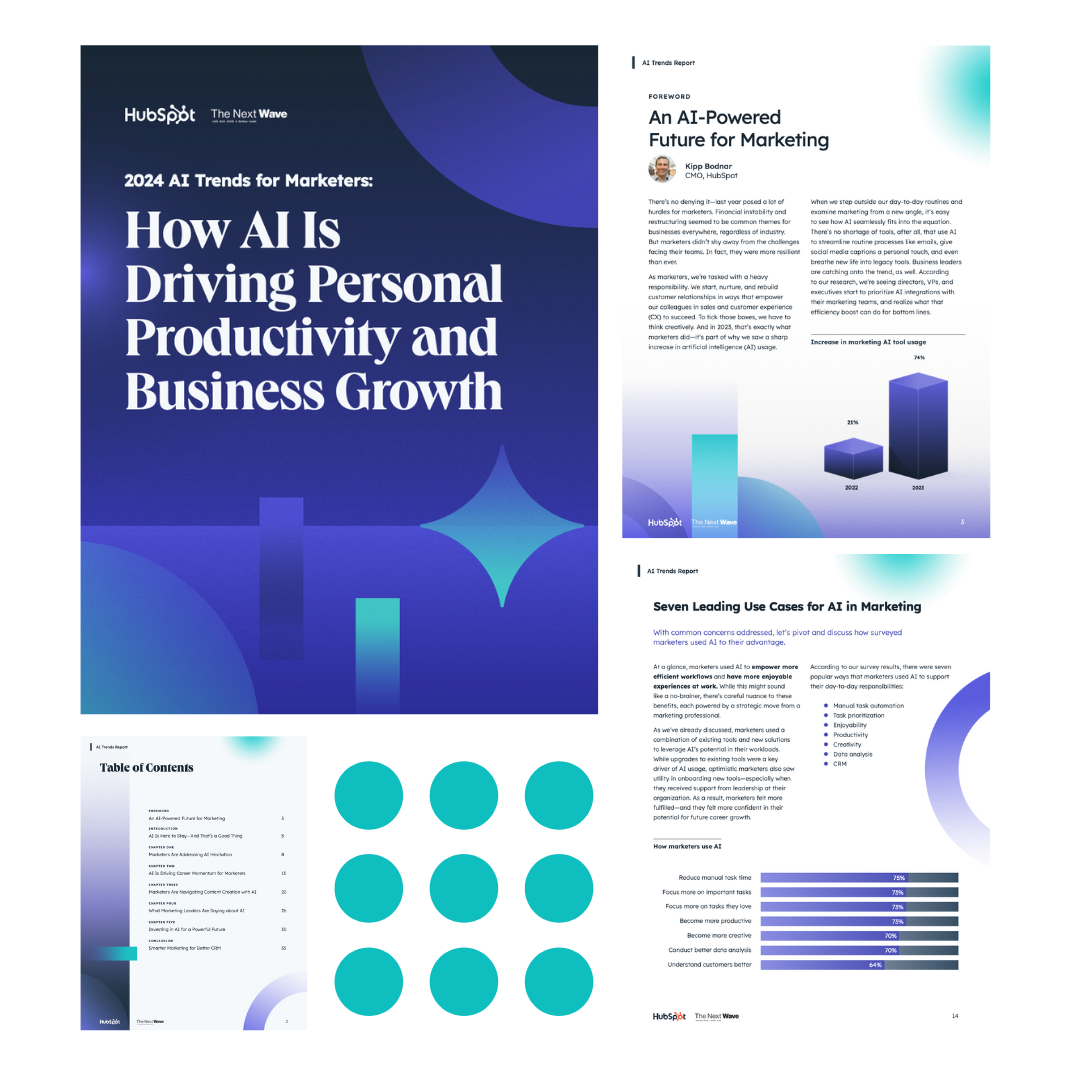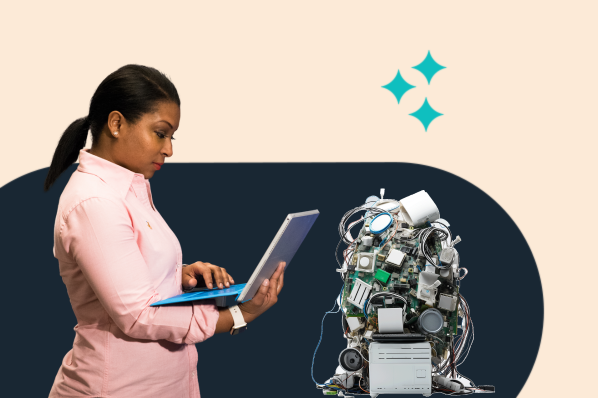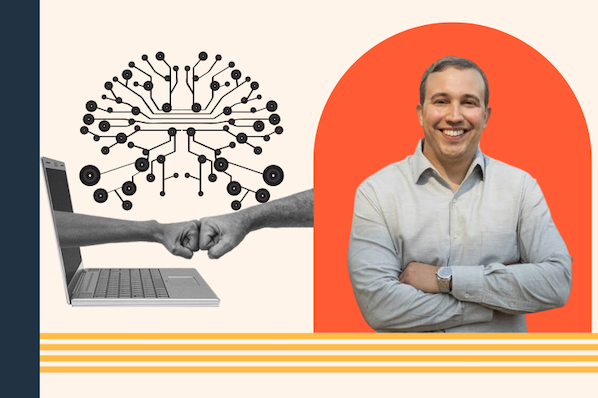ChatGPT and Google Bard have entered the chat. You're missing the party if you haven’t joined the conversation around artificial intelligence (AI) in digital marketing.
Perhaps you’re exploring AI on your own, or your boss asked you to report back on ways to implement AI in your work (welp!). Whatever your motivation, I’m here to help.
I’ll break down what AI in digital marketing is, how to use it, examples, pros and cons, and marketing strategies that benefit from AI.
Download Now: The Annual State of Artificial Intelligence in 2024 [Free Report]
Table of Contents
- What is AI in digital marketing?
- How do digital marketers use AI?
- AI in Digital Marketing Pros and Cons
- Examples of AI in Digital Marketing
- How to Use AI in Digital Marketing
- Harnessing the Power of AI
What is AI in digital marketing?
AI in digital marketing is the use of artificial intelligence to plan, execute, or optimize a company’s marketing efforts. AI marketing aims to improve the company’s marketing performance, efficiency, and cost savings.

The State of Artificial Intelligence in 2024
New research into how marketers are using AI and key insights into the future of marketing.
- Marketing AI Tools
- Practical Tips
- Trends and Statistics
- And More!
Download Free
All fields are required.

AI uses machine learning and large-language models (LLM) to analyze big data and turn it into actionable insights, automated actions, and content.
AI can even interact with customers who perform a specific behavior on your website, like clicking a button or liking a social media post.
What does this mean for you? With AI, you can analyze customer behavior, predict outcomes, automate marketing tasks, and create and personalize marketing content.
New AI tools are coming on the market every day. They promise to help marketers do their jobs faster, smarter, and more easily. Since these tools are still emerging, not every one is a home run, and the number of tools to research is overwhelming.
We’ve surveyed over 1,000 marketers to see how they use AI in their jobs and where it impacts them.
Pro tip: If you’re a HubSpot user, check out our new AI tools. We have a new content assistant, AI Blog Topic Generator and ChatSpot tools to streamline your day-to-day. Many of our features use AI, including SEO, call recordings, social media, data management, and more.

Get started with HubSpot Content Assistant.
How do digital marketers use AI?
In our survey, 64% of marketing professionals said they use AI tools in some form in their jobs, but the purpose and level of integration can vary widely. Just 21% of marketers said it’s extensively integrated into their daily workflows.
So, how are they using it? Our research found that the top three uses of AI in digital marketing are:
- Data analysis/reporting (used by 40% of marketers).
- Research, like market research or summarizing articles (39% of marketers).
- Content creation (38% of marketers).
Let’s take a closer look at the potential uses of AI in digital marketing.
Ways to Use AI in Digital Marketing
1. Data Analytics
Struggling to make sense of large data sets? Most digital marketing tools give you analytics, but marketers often have to export and piece together data from different platforms like puzzle pieces to get the big picture.
AI can collect and sift through large amounts of data from multiple marketing platforms and summarize the findings.
This will help you save time when strategizing and developing marketing assets for your campaigns.
Pro tip:HubSpot Sales Hub has conversational intelligence capabilities to help you understand how your team performs on customer calls through data-driven insights.
Learn how to use account-based marketing recommendations powered by AI.
2. Content Creation
Digital marketers can instruct AI to write marketing content, including captions, social media posts, email copy, and even blog copy. Beyond writing, marketers can use AI for multimedia like images, audio, and even video.
It’s important to note that most AI-generated content isn’t ready for publishing immediately. Most marketers today use generative AI as a starting point — whether that’s ideation, an outline, or a few paragraphs to ignite your creativity.
Just 6% of marketers using AI say that they publish AI-generated content with no changes. You should always fact-check, edit, and adjust AI’s writing to make it sound more human and on-brand.
Pro tip: HubSpot’s AI-powered Content Assistant helps you generate blog ideas, create outlines, and write blogs or marketing emails.
-2.webp?width=650&height=413&name=Untitled%20(1)-2.webp)
3. Reducing Admin Work
Like any professional role, digital marketers spend a significant amount of time sitting in meetings and doing administrative tasks.
HubSpot’s State of Artificial Intelligence report uncovered the number-one benefit of using AI in marketing: it saves them time.
In fact, business professionals save an average of two hours and 24 minutes per day by using AI and automation tools.
AI tools can tackle manual tasks like scheduling meetings, summarizing articles and research, and taking notes.
For example, 63% of marketers are using AI tools to take notes and summarize meetings. These functions aren’t sexy, but they free up a marketer’s time to spend on more important, creative parts of their jobs. Or take Superhuman, the email known for its speed. Its AI features save hours in your inbox by summarizing whole email threads, preparing draft replies in your voice, and an AI search 2-3x faster than Gmail's or Outlook's.
3. Content Personalization
Of marketers using AI, 71% say it helps them personalize the experience customers get with their company.
This means AI can change the customer’s experience depending on their online behavior or whether or not they’ve filled out a form for your company.
For example, dynamic content changes depending on the user — their name, occupation, online behavior, etc.
AI analyzes a user online and gives them a more personal experience with marketing assets, including web pages, social media posts, and emails.
6Sense is one example of a tool that leverages AI to sift through intent data. You can then understand who in your audience is looking to make a purchase so you can personalize the marketing experience.
4. Media Buying
Another way to use AI in marketing is through media buying. Gone are the days when junior media buyers hand-select websites or billboards to advertise on.
Instead, adtech platforms use AI to choose the most effective ad and media placements to reach a target audience and maximize ROI.
If you use Google Ads, you’ve already encountered the AI feature that assists with the auction process.
Other standalone AI tools like Pattern89 provide recommendations on your ad spend and enable you to target the right audience to increase performance.
Pro tip: You can also leverage AI to help you write engaging ad copy in a fraction of the time.
Campaign Assistant is a free AI-powered app that can help you generate ad copy for Google, Facebook, and LinkedIn with ease — all with just a few simple prompts.
%20hubspot%20ai%20content%20writer%20editing%20email%20copy%201%20(1).webp?)
Free AI Content Writer
Ideate, create, and share content. Easily create...
- Blog articles.
- Website copy.
- Social posts.
- And more!
5. Chatbots
One use of AI in marketing that we’ve seen for years is chatbots. Chatbots, created with natural language processing (NLP), can answer common questions, nurture leads, schedule demo calls, and more.
A chatbot can personalize the customer journey during the stage when they’re consuming marketing content. This tool can also answer customer questions.
Let’s look at Drift, for example. The company has trained its chatbot to answer questions, even outside of a pre-programmed path. This way, if a person has a question that isn’t loaded into the system, the user will still get an answer.
Pro tip: Looking to better understand how AI-powered chatbots can answer customer questions? HubSpot Academy can help. This course describes the difference between rule-based and AI-powered chatbots.
6. Automated Email Marketing Campaigns
Automated email marketing has also been around for years. However, AI tools can help produce more engaging email content and learn about your email list behaviors.
The goal is to have your marketers spend less time researching and brainstorming so they can focus on sending successful campaigns.
As AI expands and improves, automated email marketing software becomes even more important to include in your marketing stack.
HubSpot Content Assistant can help you create marketing emails. Write a prompt about what you’d like to promote — from a discount to a webinar to a blog post — and AI can generate a message with the right tone.
-2.webp?width=650&height=413&name=Untitled%20(2)-2.webp)
7. Predicting Customer Behavior
Another great use of AI in digital marketing is to forecast customer behavior and sales.
AI can predict the outcome of marketing campaigns by using historical data, such as consumer engagement metrics, purchases, time-on-page, email opens, and more.
AI helps marketers understand the predicted outcome of their campaigns and marketing assets and forecast outcomes. These insights help marketers develop better, more dynamic campaigns that produce sales and boost ROI.
8. Improving Customer Experience
Digital marketing is all about the customer experience, and AI can help marketers deliver the best experience for their visitors to convert them into leads.
AI can help increase customer retention and loyalty, delight customers with personalized content, and improve assets.
AI Marketing Pros and Cons
While AI has a lot of great benefits, it’s still an emerging technology and has some drawbacks. Let’s examine some of the advantages and disadvantages of AI in digital marketing.

Pros of AI in Digital Marketing
1. Increased ROI
As you can see, the main goal of using AI in digital marketing is to increase performance and ROI for your campaigns.
Rather than running an ineffective ad for an entire campaign, you can harness data analytics and insights to produce better marketing assets in real-time.
This saves your marketing team time and money, allowing them to work more efficiently and increase profits. Cutting staff time and production costs also boosts your ROI.
2. Speed and Efficiency
I’ll say it again: Two-thirds of marketers say that time savings is the biggest advantage of generative AI in marketing. How much? Marketers report that they save over three hours for every piece of content that they produce with AI.
This frees up your time and capacity to do more and invest your time where it matters most, but it also helps your brand.
All marketers know that being first in a market is a major advantage.
Whether you’re spinning out social media campaigns based on pop culture moments or launching digital campaigns, the ability to pivot and launch campaigns in days or even hours is pure gold.
3. Better Customer Experience
Another advantage to using AI in marketing is that it can improve your relationship with your customers.
The more personalized your recommendations are and the deeper your relationships are, the more likely they’ll become repeat buyers.
AI can also identify customers at risk of churn and put them in an automated marketing campaign to get them to re-engage with your company.
4. Data-Based Marketing Decisions
AI can make scaling your business easier, using data to analyze, predict, and create marketing assets that sell. See how your team can use artificial intelligence and automation in this course from HubSpot Academy.
Cons of AI in Digital Marketing
1. Content Quality and Accuracy
While generative AI has come a long way, its content isn’t flawless. Factual errors are a particular issue: 47% of marketers say that generative AI has provided them with inaccurate information.
If you’re going to use AI to generate content without having a human edit it, you may see a drop in the quality. The success of AI is reliant on high-quality data that is accurate and timely.
Without a human editor, AI can produce content with factual inaccuracies, bias, or a divergent tone from your brand. Using AI requires human oversight so these types of mistakes don’t happen.

The State of Artificial Intelligence in 2024
New research into how marketers are using AI and key insights into the future of marketing.
- Marketing AI Tools
- Practical Tips
- Trends and Statistics
- And More!
Download Free
All fields are required.

2. Privacy
As marketing assets have become more personalized through the years, customers are beginning to value privacy more and more.
With AI, some of these techniques require using a customer’s cookies and previous internet behavior to predict future purchases.
If your marketing team downloads and uses AI software, you’ll need to be sure you comply with privacy laws, such as GDPR.
3. Copyright Concerns
As a new technology, the legal framework for AI is still being built. Generative AI tools are trained on public content from thousands of companies, so it’s possible they could generate content that’s a little too close to your competitor’s.
Copyright laws are written around human authorship, so it’s unclear if you actually own AI-generated content in the same way.
4. Evaluating Non-Quantifiable KPIs
It might be hard to get buy-in to invest in AI at your company because there are non-quantifiable KPIs at play.
Certain metrics will be easy to track, but others — like improving the customer experience, increasing brand awareness, or improving reputation — will be much harder. That’s why it’s important to have the right measurement tools, like HubSpot’s marketing analytics platform, in place.
The platform lets you track KPIs across all your marketing channels under unified dashboards — from website traffic and page views to the number of leads generated through ad campaigns, and more.
Examples of AI in Digital Marketing
At this point, you might be wondering, “Okay, but how does this look in practice?” Let’s review some real-life examples of how big media companies have used AI in their digital marketing.
1. Netflix
If you’re in marketing, you know you have to deliver the right message to the right person at the right time. Netflix uses AI to do this. How?
On a Netflix Tech Blog, the company explains how it uses previous viewing history to determine the artwork for recommended movies or TV shows.
For example, if you’ve watched a lot of one actor’s movies, they might recommend another movie they’re in. But if the artwork doesn’t show off the actor, you may click away.
So, when the movie is recommended to this specific viewer, the artwork will showcase that actor.
Or maybe a viewer tends to watch more comedies than romances. When Netflix recommends a movie, they might change the artwork to show off comedic scenes versus romantic moments from the film.
Let’s take a look at how Netflix would recommend the movie Good Will Hunting to someone who watches romance movies versus the artwork they’d use to recommend the movie to someone who watches comedies.

So, why does Netflix do this? The goal is to increase conversion rates and improve the customer experience on their platform.
2. Spotify
Spotify uses a similar approach to Netflix. The company will use AI to understand a user’s music interests, podcast favorites, purchase history, location, brand interactions, and more.
Then, customized playlists and recommendations are curated for each user.
-3.webp?width=650&height=468&name=Untitled%20(3)-3.webp)
This type of content personalization has helped major media companies like Spotify become top streaming platforms. But the personalization doesn’t end there.
Spotify will also send automated email marketing messages with personalized recommendations.
The goal? Create automated marketing messages and assets that will convert a user because the message is specific to that customer.
3. Amazon
Two major use cases for AI in marketing are forecasting sales and analyzing data. Amazon uses AI to do just that.
When you go on Amazon, there is a recommended products section that uses predictive analytics to determine if a customer is likely to make a purchase.
%20(2).webp?width=650&height=160&name=Untitled%20(1)%20(2).webp)
This helps the marketing teams at Amazon know what products to place in front of which customers. Plus, they can predict how well a product will sell based on their recommended product campaigns.
This type of AI helps increase conversions, improve customer satisfaction, and measure the overall success and ROI of various marketing campaigns.
4. Dreamhost

DreamHost's Business Name Generator uses AI to offer custom-tailored business name ideas. Just input keywords related to your business, and it suggests unique names in real-time and also checks domain availability to help you kickstart your online presence.
4. StoryChief's AI Marketing Agent: William

StoryChief’s AI Marketing Agent, William, generates a custom content strategy tailored to your brand by simply entering your website URL. He suggests content pillars, defines your brand voice, identifies your target audience, and even pre-fills your content calendar.
But it doesn't stop there. William continuously monitors content performance, provides traffic audits, and offers fresh content ideas to keep you ahead of trends. Plus, you stay in control — curating, approving, and publishing content as you see fit.
How to Use AI in Digital Marketing
If you haven’t started deploying AI in your digital marketing strategies, this is your year. Now, 46% of marketers feel overwhelmed by the prospect of integrating AI tools into their daily process or workflow.
But the best way to eat an elephant, as Desmond Tutu once said, is one bite at a time.
I’ve learned through experience that the best way to make any large organizational change is through a strategic, systematic, and empathetic approach.
-1.webp?width=650&height=433&name=howto%20(2)-1.webp)
1. Define your goals.
Before starting out, determine what goal or objective you want to reach. Do you want to make your campaigns more effective? Do you want to save your team time or money?
Don’t skip this step — you can’t determine success without defining your goals and quantifiable KPIs.
2. Audit your infrastructure.
To start, put together a small team to analyze your current tools and infrastructure and find opportunities for adoption.
Write a report with all possible areas of implementation, potential outcomes, and what resources you would need to make it happen.
Assess the quality, quantity, and accessibility of your data to see how suitable it is for AI applications. Don’t forget to identify potential challenges or negative outcomes along with the positive.
You can’t throw out your marketing playbook and replace it with AI strategies overnight, so identify your top two to three areas where you want to test initially.
These don’t all have to be huge initiatives like overhauling your email marketing — small things can add up. For example, I love using AI tools for note-taking from meetings and transcribing interview recordings.

The State of Artificial Intelligence in 2024
New research into how marketers are using AI and key insights into the future of marketing.
- Marketing AI Tools
- Practical Tips
- Trends and Statistics
- And More!
Download Free
All fields are required.

3. Audit staff capabilities.
Another area you should assess is whether your staff has the training and knowledge to implement these programs.
You’ll likely need to invest in training for your current staff, hire a consultant, or create a new position to drive forward your AI initiatives.
Case in point, 62% of marketing leaders say they’ve already considered hiring an employee specifically for AI, and 40% of those who haven’t say they plan to.
Your team likely already has some worries they could lose their jobs to AI, so make sure to position this as an opportunity for your team to reskill, learn, and become better marketers.
4. Select the right AI marketing tools.
Once you’ve identified your goals and top areas for implementation, it’s time to build your toolbox. Your current tools may already offer an AI feature.
For example, if you’re a HubSpot customer, the platform also offers a live chat feature with an integrated chatbot builder. You can set up AI-powered chatbots that qualify or route leads and more via a no-code interface. But it’s smart to look at all of the options on the market.
First, decide whether you’ll use an out-of-the-box AI solution versus a custom one. An example of an out-of-the-box AI solution would be Jasper, ChatGPT, or Google Bard.
A custom solution, which you can create with APIs for an open-source AI like Llama 2, can be a powerful solution for long-term success. You can connect and train AI on your proprietary data or train a GPT on your own voice and style.
This approach takes additional expertise, so you’d need to work closely with a consultant or your IT department.
5. Test and analyze AI.
At last, it’s time to test the waters. Take your top two to three areas of implementation and launch your programs. Set a timeframe and some target KPIs to watch so you can compare results.
For instance, if you want to test AI-written and AI-placed social media ads, run a trial period of a month. Monitor and edit the content throughout the month and document the process.
Once you’re done, compare the performance of AI-generated, human-generated, and AI-assisted content to see how it did and create a plan moving forward.
6. Build a culture of innovation.
As I mentioned, getting your team on board is key with any new technology change. Ask your team for feedback, bring them along in the process, and assure them that AI is intended to make them better, not replace them.
Harnessing the Power of AI
Marketing teams can scale their operations with AI, and it doesn’t have to break the bank.
However, it’s important to keep in mind the limitations of AI, even as the technology continues to get better over time in the changing marketing landscape.
While you might be able to use it to aid several marketing campaigns (and should), it isn’t replacing marketers just yet.

The State of Artificial Intelligence in 2024
New research into how marketers are using AI and key insights into the future of marketing.
- Marketing AI Tools
- Practical Tips
- Trends and Statistics
- And More!
Download Free
All fields are required.








![Which LLM Should You Use for Your Business? [Pros and Cons]](https://www.hubspot.com/hubfs/which%20llm%20to%20use.png)

![Is it Real or AI? Test Your Detection Skills [Round 4]](https://www.hubspot.com/hubfs/real%20or%20ai%204.png)

